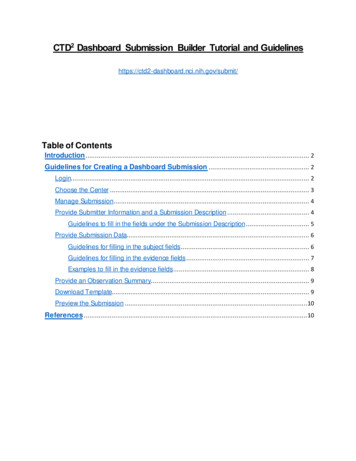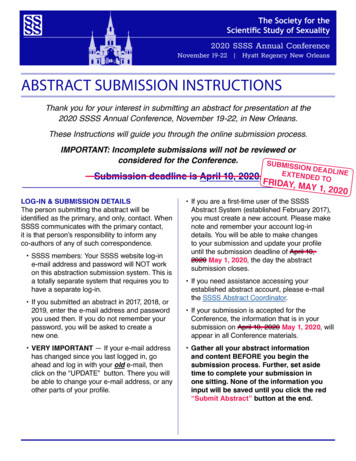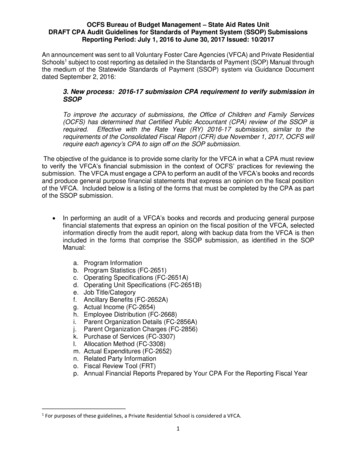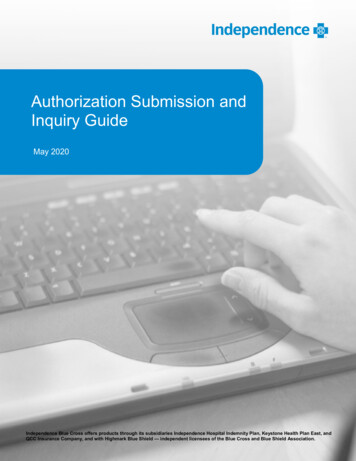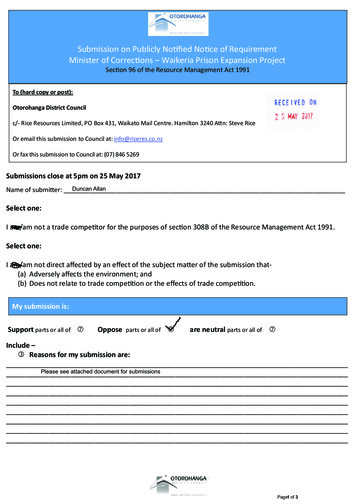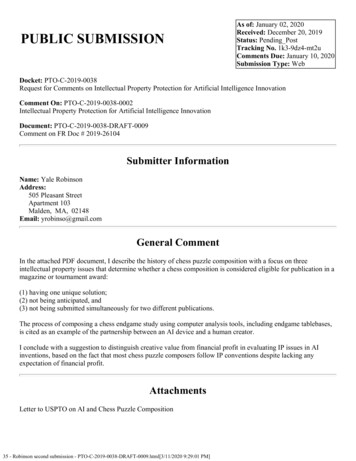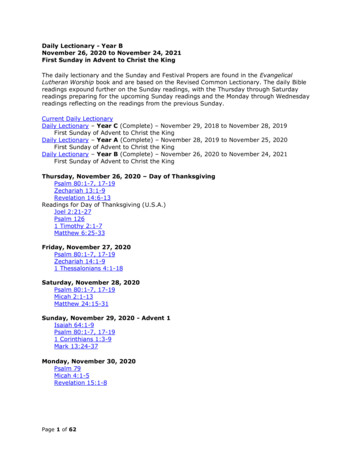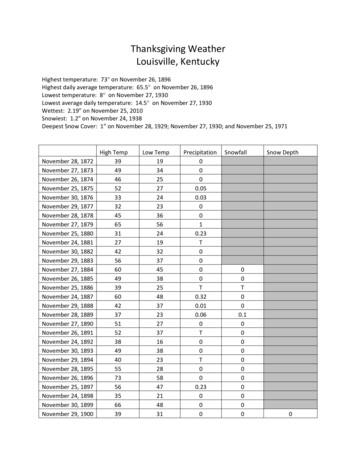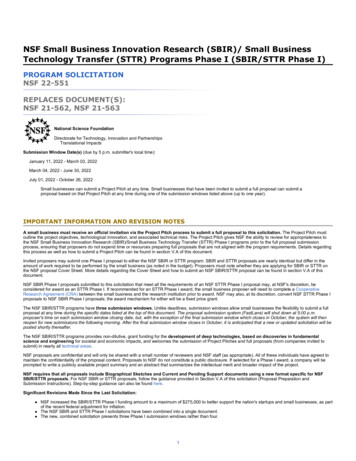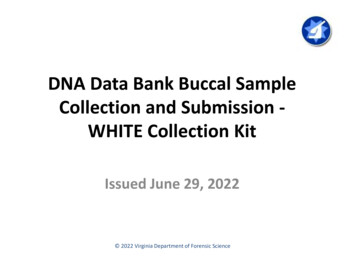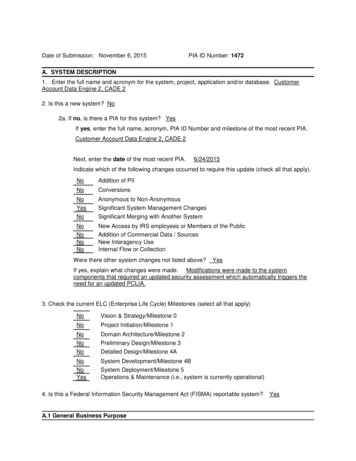
Transcription
Date of Submission: November 6, 2015PIA ID Number: 1472A. SYSTEM DESCRIPTION1. Enter the full name and acronym for the system, project, application and/or database. CustomerAccount Data Engine 2, CADE 22. Is this a new system? No2a. If no, is there a PIA for this system? YesIf yes, enter the full name, acronym, PIA ID Number and milestone of the most recent PIA.Customer Account Data Engine 2, CADE 2Next, enter the date of the most recent PIA.6/24/2015Indicate which of the following changes occurred to require this update (check all that apply).NoAddition of PIINoConversionsNoYesNoAnonymous to Non-AnonymousSignificant System Management ChangesSignificant Merging with Another SystemNoNoNoNoNew Access by IRS employees or Members of the PublicAddition of Commercial Data / SourcesNew Interagency UseInternal Flow or CollectionWere there other system changes not listed above?YesIf yes, explain what changes were made. Modifications were made to the systemcomponents that required an updated security assessment which automatically triggers theneed for an updated PCLIA.3. Check the current ELC (Enterprise Life Cycle) Milestones (select all that apply)NoVision & Strategy/Milestone 0NoProject Initiation/Milestone 1NoNoNoDomain Architecture/Milestone 2Preliminary Design/Milestone 3Detailed Design/Milestone 4ANoNoYesSystem Development/Milestone 4BSystem Deployment/Milestone 5Operations & Maintenance (i.e., system is currently operational)4. Is this a Federal Information Security Management Act (FISMA) reportable system?A.1 General Business PurposeYes
5. What is the general business purpose of this system? Provide a clear, concise description of thesystem, application or database, the reason for the system, and the benefits to the IRS to use theinformation, and how the information will be used.The IRS Individual Master File (IMF) is currently the IRS authoritative data source (ADS) forindividual tax account data. This means that IMF is the system that other IRS systems currentlyrely on for individual tax account data necessary for tax administration. CADE 2 will eventuallyreplace IMF as the ADS for individual tax account data, providing information feeds to other IRSinternal systems so they can process tax returns. One such application is the Integrated DataRetrieval System (IDRS) where active tax cases are handled. To accomplish this, CADE 2 containsall individual taxpayer account information in a relational database which is designed to recognizerelationships between the information in order to improve the speed at which refunds areprocessed. Using key fields and linking data tables together allows the data to be located quickerand thus improving processing times. Along with the improved times, CADE 2 allows IRS frontlineemployees to view more accurate and timely account information due to modifications that willupdate information in the system more frequently, on a daily verses a weekly basis. This allowsCADE 2 to ensure accuracy, completeness, and enhanced availability of information for IRSemployees who rely on this information to process refunds and improves services to taxpayers byallowing refunds to be processed faster and with greater accuracy. CADE 2 will also continue toevolve and improve its existing capabilities to ensure data integrity is not compromised. To achievethis CADE 2 is implementing further enhancements through smaller projects to address thechanges that are expected to take place during the continual transition from IMF. This includesissues like the potential for irregularities in data formats, as well as, providing data and reports toother IRS databases (such as the Integrated Production Model (IPM) within Big Data Analytics(BDA)) and applications or business offices requiring access to taxpayer data or transcripts. Onesuch CADE 2 project is the Database Conversion (DBC) process in which IMF Annual and MidYear Conversion changes are applied to the CADE 2 database while retaining CADE 2 historicaldata (changes to transactions, tax modules, balances, tax return records, taxpayer records, andpending events). Another ongoing effort is the Production Support Environment (PSE) used forbreak-fixes and data validation to ensure accuracy and code validation.B. PII DETAIL6. Does the system use, collect, receive, display, store, maintain, or disseminate IR Code 6103 taxpayerinformation; or any type of Sensitive but Unclassified (SBU) or Personally Identifiable Information(PII)? Yes6a. If yes, does the system use, collect, receive, display, store, maintain, or disseminate SocialSecurity Numbers (SSN s) or tax identification numbers (i.e. last 4 digits, etc.)? YesIf yes, check who the SSN (or tax identification number) is collected on.YesOn PrimaryYesOn SpouseYesOn DependentIf yes, check all types SSN s (or tax identification numbers) that apply to this system:YesYesYesYesYesSocial Security Number (SSN)Employer Identification Number (EIN)Individual Taxpayer Identification Number (ITIN)Taxpayer Identification Number for Pending U.S. Adoptions (ATIN)Practitioner Tax Identification Number (PTIN)Describe the planned mitigation strategy and forecasted implementation date to mitigate oreliminate the use of SSN s (or tax identification numbers).The SSN is the primary means of querying the database. It is the only unique identifierassociated with taxpayers, spouses, and dependents that can be used to ensure the correct
record is accessed by older IRS systems. CADE 2 continues to examine all new requeststhat state a need to access the SSN to ensure there is a specific requirement and businessapproval to access the SSN in order to perform official IRS functions. Prior to any futureconnections to downstream systems the IRS shall examine alternative solutions and willwork with system owners to try and mitigate the need for the SSN. In addition, IRS willannually review CADE 2 SSN uses and continue to find ways to replace, mask, or truncatethe SSN. In addition, IRS is undertaking efforts to expand the use of a modified systemidentifier, Document Locator Number (DLN), or a truncation of the SSN. A plan is reviewedannually examining reports, system connections, and requests that use the SSN in order todetermine if an alternative can be used.6b. Does this system contain other (non-SSN) PII that it uses, collects, receives, displays, stores,maintains, or disseminates? (i.e. Names, addresses, etc.) YesIf yes, specify the oNoNoNoYesNoNoNoYesPII ElementNameMailing addressPhone NumbersE-mail AddressDate of BirthPlace of BirthSEIDMother's Maiden NameProtection Personal IdentificationNumbers (IP PIN)Internet Protocol Address (IP Address)Criminal HistoryMedical InformationCertificate or License NumbersVehicle IdentifiersPassport NumberAlien (A-) NumberFinancial Account NumbersPhotographic IdentifiersBiometric IdentifiersEmployment (HR) InformationTax Account oNoNoNoNoNoNoNoNoNoNoYes6c. Does this system contain SBU information that is not PII, it uses, collects, receives, displays,stores, maintains, or disseminates?YesIf yes, select the types of SBUSelectedYesSBU NameAgency SensitiveSBU DescriptionInformation which if improperly used or disclosed could
InformationNoProcurementsensitive dataNoOfficial Use Only(OUO) or LimitedOfficial Use(LOU)NoProprietary dataYesProtectedInformationNoPhysical ionadversely affect the ability of the agency to accomplish itsmissionContract proposals, bids, etc.Information designated as OUO or LOU is information that: isexempt under one of the statutory Freedom of Information Actexemptions; is prohibited by other laws or regulations; wouldsignificantly impede the agency in carrying out a responsibilityor function; or would constitute an unwarranted invasion ofprivacy.Business information that does not belong to the IRSInformation which if modified, destroyed or disclosed in anunauthorized manner could cause: loss of life, loss of propertyor funds by unlawful means, violation of personal privacy orcivil rights, gaining of an unfair procurement advantage bycontractors bidding on government contracts, or disclosure ofproprietary information entrusted to the GovernmentSecurity information containing details of serious weaknessesand vulnerabilities associated with specific systems andfacilitiesInformation concerning IRS criminal investigations or theagents conducting the investigations.6d. Are there other types of SBU/PII used in the system? No6e. Cite the authority for collecting SBU/PII (including SSN if relevant)YesPII for federal tax administration is generally Internal Revenue Code Sections 6001, 6011, 6012e(aYesSSN for tax returns and return information is Internal Revenue Code Section 6109NoSSN for personnel administration (IRS Employees) is 5 USC & Executive Order 9397NoPII for personnel administration is 5 USCNoPII about individuals for Bank Secrecy Act compliance 31 USCNoInformation by CI for certain money laundering cases may be 18 USC6f. Has the authority been verified with the system owner?YesB.1 BUSINESS NEEDS AND ACCURACY7. Explain the detailed business needs and uses for the SBU/PII, and how the SBU/PII is limited only tothat which is relevant and necessary to meet the mission requirements of the system. If SSNs (ortax identification numbers) are used, explicitly explain why use of SSNs meets this criteria. Bespecific.The Personally Identifiable Information (PII) collected from the IRS 1040, 1040A, 1040X, and allsupplemental documentation filed along with an individual's tax information is used to validate anindividual's taxes. The only SBU/PII data CADE 2 uses is that which is necessary to assess thetaxes. This includes the SSN since it is the one unique identifier that taxpayers have to identifythemselves.
8. How is the SBU/PII verified for accuracy, timeliness, and completeness? Explain how stepsare taken to ensure that all information maintained by the system that is used by IRS tomake any adverse determination about an individual's rights, benefits, and/or privileges ismaintained with such accuracy, relevance, timeliness, and completeness as isreasonably necessary to assure fairness to the individual in the determinationWith CADE 2 running daily updates the database is able to validate and ensure data completenessby assessing the data format and flagging errors that could affect a tax return assessment. Amainframe application validates data through a series of applied business rules. During thisprocessing, if any data elements are determined to be outside of the expected formattingparameters, the element is flagged for further analysis by the system. If the system is unable tocorrect the element, a ticket is created and the element will be examined by appropriate personnelthat can resolve the issue. In the future, CADE 2 will verify the accuracy of SSNs against SocialSecurity records through another IRS application. Taxpayer information will continue to beprocessed by using IMF until CADE 2 is officially accepted by both the Chief Financial Officer andGovernment Accountability Office (GAO) as the authoritative data source for individual tax accountdata. In addition, when other internal systems that rely on CADE 2 data discover inaccurate orincomplete information due to their direct interaction with individual taxpayer, the information isresubmitted through appropriate processes and the taxpayer information is updated.C. PRIVACY ACT AND SYSTEM OF RECORDS9. Are 10 or more records containing SBU/PII maintained, stored, and/or transmitted by or through thissystem? Yes9a. If yes, are records in the system retrieved by any personal identifier (e.g., name, SSN,Photograph, IP Address) for an individual? YesIf yes, is there a System of Records Notice(s) or SORNs that addresses the PII records in thissystem? YesIf yes, enter the SORN number(s) and the complete the name of the SORN.SORNS NumberSORNS Name24.030CADE Individual Master File24.046CADE Business Master File34.037Audit trail and security records systemIf yes, does the System of Records Notice(s) (SORN) published in the Federal Registeradequately describe the records as required by the Privacy Act? YesD. RESPONSIBLE PARTIES10. Identify the individuals for the following system roles. N/AE. INCOMING PII INTERFACES
11. Does the system receive SBU/PII from other system or agencies?Yes11a. If yes, does the system receive SBU/PII from IRS files and databases?YesIf yes, enter the files and databases.System NameCurrentPIA?PIA ApprovalDateSA 5/02/2014Yes05/02/2014Integrated Data Retrieval System(IDRS)Individual Master File (IMF)11b. Does the system receive SBU/PII from other federal agency or agencies?11c. Does the system receive SBU/PII from State or local agency (-ies)?11d. Does the system receive SBU/PII from other sources?NoNoNo11e. Does the system receive SBU/PII from Taxpayer forms?No11f. Does the system receive SBU/PII from Employee forms (such as the I-9)?NoF. PII SENT TO EXTERNAL ORGANIZATIONS12. Does this system disseminate SBU/PII?Yes12a. Does this system disseminate SBU/PII to other IRS Systems?YesIf yes, identify the full name and acronym of the IRS system(s) that receive SBU/PII from thissystem.System NameIntegrated Data Retrieval System(IDRS)Big Data Analytics (BDA)Integrated Production Model(IPM)CurrentPIA?PIA ApprovalDateSA entify the authority and for what purpose? The authority for processing taxpayer informationis 5 U.S.C. 301 and 26 U.S.C. 7801. The purpose for sharing taxpayer information received byother IRS systems and processed by CADE 2 is to assess and distribute tax returns. Informationfrom CADE 2 is shared with IDRS for the purpose of providing data for open cases and sharedwith BDA and IPM for the purpose of providing data for a new data store that will addressdownstream system data requirements. CADE 2 is only a repository for taxpayer data and it doesnot interact directly with taxpayers like other systems regarding return transactions andauthorized taxpayer representatives12b . Does this system disseminate SBU/PII to other Federal agencies?No
12c. Does this system disseminate SBU/PII to State and local agencies?No12d. Does this system disseminate SBU/PII to IRS or Treasury contractors?12e. Does this system disseminate SBU/PII to other Sources?NoNoG. PRIVACY SENSITIVE TECHNOLOGY13. Does this system use social media channels?No14. Does this system use privacy-sensitive technologies such as mobile, cloud, global position system(GPS), biometrics, RFID, etc.? No15. Does the system use cloud computing?16.NoDoes this system/application interact with the public?NoH. INDIVIDUAL NOTICE AND CONSENT17. Was/is notice provided to the individual prior to collection of information?Yes17a. If yes, how is notice provided? Was the individual notified about the authority tocollect the information, whether such is mandatory or voluntary, the purpose for which theinformation will be used, with whom the information may be shared, and the effects, ifany, if they decide not to provide any of the requested information?Notice is provided to individuals by other IRS applications or through forms (e.g., 1040 forms) thatinteract directly with the taxpayer at the time of collection. Due Process is provided pursuant to 5USC.18. Do individuals have the opportunity to decline from providing information and/or from consenting toparticular uses of the information?Yes18a. If yes, describe the mechanism by which individuals indicate their consent choice(s):CADE 2 does not collect any information directly from taxpayers. All information that is maintainedby CADE 2 comes from the submission of 1040 forms submitted directly to the IRS through otherIRS systems. Information from the 1040 form is collected and stored in IMF and is thensubsequently shared with CADE 2. In the future, when CADE 2 is accepted as the ADS data will besent directly to the CADE 2 DB. The 1040 form provides taxpayers information regarding theopportunity to decline or consent to providing the information. Due Process is provided pursuant to 5USC.19. How does the system or business process ensure due process regarding information access,correction and redress?CADE 2 is only a repository of taxpayer information submitted directly to the IRS through other IRSapplications. CADE 2 does not interact with taxpayers directly and thus "due process" is addressedby other IRS applications that directly interact with taxpayers. Any issues that are identified bythese other means will submit changes to CADE 2 through automated methods so an auditablerecord may be maintained. Due Process is provided to 5 USC.I. INFORMATION PROTECTION20. Identify the owner and operator of the system (could be IRS owned and Operated; IRS owned,contractor operated; contractor owned and operated)
IRS Owned and Operated21. The following people have access to the system with the specified rights:IRS Employees?YesIRS Employees?Yes/NoUsersManagersSys. AdministratorsDevelopersContractor Employees?NoNoYesYesAccess Level(Read Only/Read Write/Administrator)AdministratorRead And WriteYesContractor Employees?Contractor UsersContractor ManagersContractor Sys. Admin.Contractor DevelopersYes/NoNoNoYesYesAccess LevelAdministratorRead and WriteBackground Invest.HighHigh21a. How is access to SBU/PII determined and by whom? All contractors and employees must gothrough the Public Trust Clearance process before access is considered. Once cleared, anIRS employee or contractor must complete the proper request forms before access to CADE2 is obtained. All access must be approved by the user's manager who reviews the accessrequest form at the time of submission and on an annually basis. The systemadministrators/approvers will also verify group membership to ensure system rights arelimited based on the employee or contractor’s need-to-know in order to perform their officialduties. For access to an environment where a new or modified system is being tested (i.e., anon-production supporting environment) users must complete the necessary SBU datatraining, complete an access request form, and in some cases as outlined by therequirements set forth within the Internal Revenue Manual (IRM), submit an elevated accessletter that is approved by the Associate Chief Information Officer prior to granting access.21b. If computer matching occurs, can the business owner certify that it meets requirements of IRM11.3.39 Disclosure of Official Information, Computer Matching & Privacy Protection Act ?Not ApplicableI.1 RECORDS RETENTION SCHEDULE22. Are these records covered under the General Records Schedule (GRS), or have a National Archivesand Records Administration (NARA) archivist approved a Record Control Schedule (RCS) for theretention and destruction of official agency records stored in this system? Yes22a. If yes, how long are the records required to be held under the corresponding RCS and howare they disposed of? In your response, please include the complete IRM number 1.15.XXand specific item number and title.CADE 2 development records continue to follow RCS (Document 12990) InformationTechnology Schedule 17. As for production records, a request for records dispositionauthority for the CADE 2 and its associated records is currently being drafted with theassistance of the IRS Records and Information Management (RIM) Program Office.When approved by NARA, disposition instructions for CADE 2 inputs, system data,
outputs, and system documentation will be published within the IRM or as part of theRecords Control Schedule. The expectation is that for the Enterprise ComputingCenter - Martinsburg, will continue to follow IRM 2.7.9. Smaller files and documentsthat fall outside the schedule are addressed by the project and kept only as long asnecessary in order to perform their task.I.2 SA&A OR ECM-R23. Has the system been through SA&A (Security Assessment and Authorization) or ECM-R (EnterpriseContinuous Monitoring Reauthorization)? Yes23a. If yes, what date was it completed?4/21/201523.1 Describe in detail the system s audit trail. The SA&A controls are assessed annually in accordancewith the Annual Security Control Assessment (ASCA) to ensure system security and privacy compliance.Vulnerability scans and policy checkers are routinely run and if a vulnerability is detected efforts are madeto address the concern upon discovery. In addition, CADE 2 development areas that utilize live dataperiodically review staff lists to ensure listed support personnel require the level of access requested.J. PRIVACY TESTING24. Does the system require a System Test Plan? Yes24b. If yes, Is the test plan in process or completed: In ProcessIf in process, when is the test plan scheduled for completion? 12/31/201524.3 If completed/ or in process, describe what testing and validation activities have beenconducted or are in progress to verify and validate that the applicable Privacy Requirements(listed in header) have been met?The CADE 2 system is going through a continuous System Test Plan due to its ongoingenhancements. Each enhancement has a different set of design requirements which includessecurity and privacy requirements that are assessed. The overarching privacy requirements arefurther defined into testable requirements that are reviewed by the development team. Theidentified requirements will then be tested and documented. Any risks that are discovered arereviewed and addressed. All this is being coordinated by Requirements Engineering ProgramOffice and Cybersecurity and tracked in the Rational Requirements Tool and developer securityassessment testing.K. SBU Data Use25. Does this system use, or plan to use SBU Data in Testing?Yes25a. If yes, was permission granted per the requirements of Form 14664, SBU Data UseQuestionnaire or Form 14665, SBU Data Use Request?YesIf yes, provide the date the permission was granted.3/31/2015.25b. If yes, was testing performed in conformance with IRM 10.8.8 Information Technology (IT)Security, Sensitive But Unclassified (SBU) Data Policy? Yes
L. NUMBER AND CATEGORY OF PII RECORDS26. Identify the number of individual records in the system for each category:26a. IRS Employees:Not Applicable26b. Contractors:Not Applicable26c. Members of the Public: More than 1,000,00026d. Other:NoM. CIVIL LIBERTIES27. Does the system maintain any information describing how any individual exercises their rightsguaranteed by the First Amendment? No28. Is the system information used to conduct data-mining as defined in the Implementing the 9/11Commission Recommendations Act of 2007, Public Law 110-53, Section 804? No29. Will this system have the capability to identify, locate, and monitor individuals or groups of people? NoN. ACCOUNTING OF DISCLOSURES30. Does the system include or require disclosure of tax or employee information to anyone other thanIRS employees in the performance of their duties, or to the person to whom the information pertainsor to a 3rd party pursuant to a Power of Attorney, tax or Privacy Act consent? NoEnd of Report
7. Explain the detailed business needs and uses for the SBU/PII, and how the SBU/PII is limited only to that which is relevant and necessary to meet the mission requirements of the system. If SSNs (or tax identification numbers) are used, explicitly explain why use of SSNs meets this criteria. Be specific.
